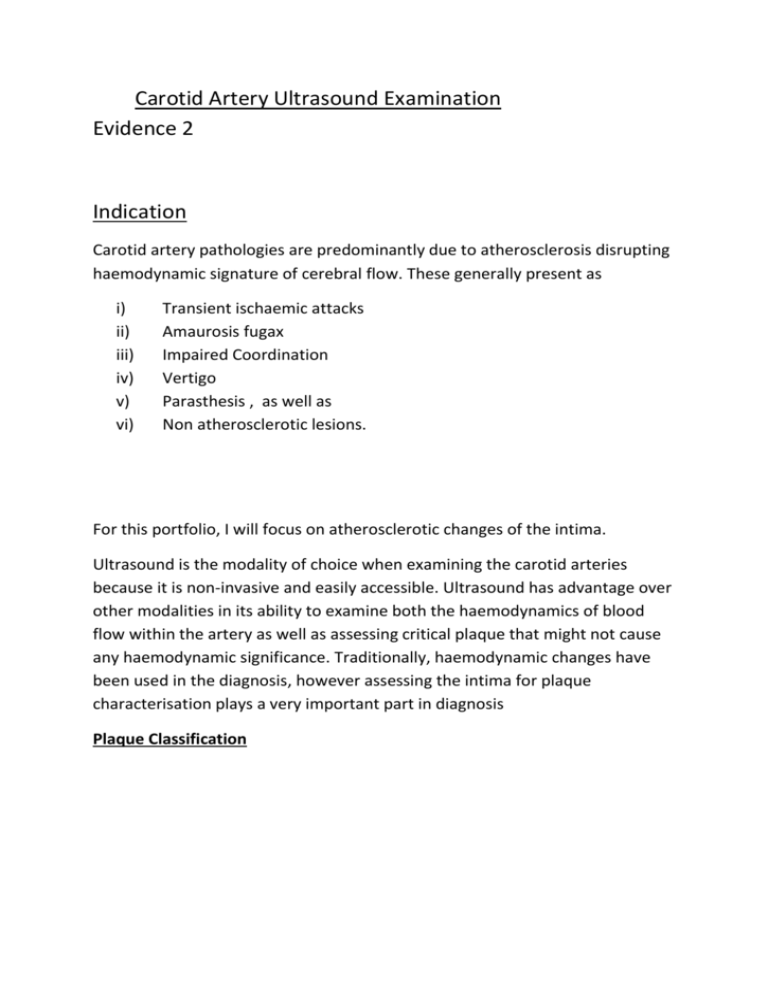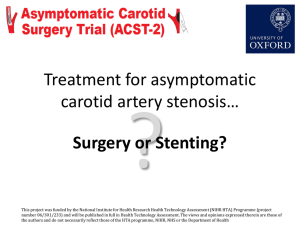Carotid Artery Ultrasound: Plaque & Stenosis Assessment
advertisement

Carotid Artery Ultrasound Examination Evidence 2 Indication Carotid artery pathologies are predominantly due to atherosclerosis disrupting haemodynamic signature of cerebral flow. These generally present as i) ii) iii) iv) v) vi) Transient ischaemic attacks Amaurosis fugax Impaired Coordination Vertigo Parasthesis , as well as Non atherosclerotic lesions. For this portfolio, I will focus on atherosclerotic changes of the intima. Ultrasound is the modality of choice when examining the carotid arteries because it is non-invasive and easily accessible. Ultrasound has advantage over other modalities in its ability to examine both the haemodynamics of blood flow within the artery as well as assessing critical plaque that might not cause any haemodynamic significance. Traditionally, haemodynamic changes have been used in the diagnosis, however assessing the intima for plaque characterisation plays a very important part in diagnosis Plaque Classification ultrasoundpaedia n images of normal intima, smooth echogenic intima, with a hypoechoic intima media. Thickness of equal or less than 0.9mm Soft plaque low level echoes , smooth surface. May be undetected unless colour or power Doppler is used. Fibrotic plaque is thickened intima with echogenic non shadowing . This plaque is stable but needs to be monitored Complex plaque is significant plaque. It contains echogenic plaque with shadowing. This type of plaque has an irregular surface. On colour Doppler, ulceration and necrosis is usually demonstrated. Necrotic plaque has potential to dislodge and travel upstream resulting in patient’s symptoms. Identifying the different types of plaque is diagnosis enough even if the stenosis does not result in haemodynamic changes. When we find plaque, we need to determine the degree of stenosis it causes. Measuring the residual lumen and pulse wave Doppler are methods used to evaluate the degree of stenosis Two trials , European and North American studies, using B Mode imaging evaluate the degree of stenosis by measuring residual lumen North American Symptomatic Carotid Endarterectomy Trial European Carotid Surgery Trial Measures stenosis by comparing lumen diameter Measures stenosis by comparing overall at level of stenosis to distal lumen diameter diameter to residual lumen diameter at maximum stenosis Comparing diameters is also used to assess the degree of stenosis. This can be used in follow up scans. Pulse wave Doppler is used to demonstrate haemodynamic changes within the Carotid Artery that occur due to plaque. Both flow velocities and type of waveform are diagnostic Below is a table of diagnostic values (ASUM guidelines revised March 2008) Stenosis Grade 0 < 15 % 18- 49 % 50-69% 70-79% Pulse wave Doppler criteria Normal waveform. No spectral broadening Deceleration with spectral broadening PSV <125 cm/sec Spectral broadening PSV < 125 cm/sec Spectral broadening PSV>125cm/sec EDV 110 cm/sec ICA?CCA >2 Spectral broadening PSV >270cm/sec EDV >110cm/sec ICA/CCA >4 80-99% Occlusion Spectral broadening PSV>270cm/sec EDV >140 cm/sec ICA/CCA >4 No flow on colour and power dopplerTerminal thump on pulse wave doppler Signature pulse wave Dopplers Common Carotid (CCA) High resistance flow with prolonged diastolic flow. (Combination of both Internal and external Carotid waveforms) No spectral broadening Internal Carotid Low resistance flow Prolonged flow in diastole No spectral broadening External Carotid artery High resistance flow with low diastole Prominent dichrotic notch compared to internal Carotid waveform No spectral broadening Severe stenosis in Internal Carotid artery Above image shows very high Peak Systolic Velocity causing aliasing. Very high end dystolic velocity with spectral broadening. References 1 Hedrick, Wayne R., Davis Hykes L., and Dale Starchman E. Ultrasound Physics and instrumentation. St Louis MO. Elsevier Mosby 2005. 2 Gill, Robert. The physics and technology od diagnostic ultrasound: A Practitioner’s guide. Abbotsford N.S.W.:High frequency Publishing 2012 3 Myers, Kenneth A. and Amy clough. Making sence of vascular Ultrasound. A Hands on Guide. London:Arnold 2004 4 Allan, Paull. P. clinical Doppler ultrasound [Oxford]: Churchill Livingstone/Elsevier. 2006











